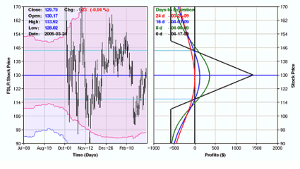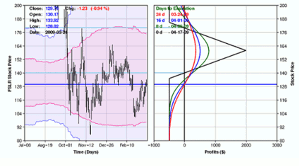This strategy is best used when a trader expects the underlying stock to move somewhat higher, but does not have a specific forecast regarding the magnitude of the move, writes the staff at Investopedia.com.
Individuals trade options for a variety of reasons. Some people trade them in order to speculate on the expectation of a given price moment, while others use options to hedge an existing position. Others use more advanced strategies in hopes of generating extra income on a regular basis. All of these are valid objectives and can be successful if done correctly. Still, there is a whole range of unique strategies along the option trading strategy spectrum that offer outstanding reward-to-risk potential for those willing to consider the possibilities. One such strategy is the out-of-the-money butterfly spread (heretofore referred to as the OTM butterfly).
Definition of a Butterfly Spread
Before delving into the OTM butterfly, let’s first define what a basic butterfly spread is; a butterfly spread represents a strategy completely unique to option trading. The most basic form of a butterfly spread involves buying one call option at a particular strike price while simultaneously selling two call options at a higher strike price and buying one other call option at an even higher strike price. When using put options, the process is to buy one put option at a particular strike price while simultaneously selling two put options at a lower strike price and buying one put option at an even lower strike price.
The net effect of this action is to create a "profit range," a range of prices within which the trade will experience a profit over time. A butterfly spread is most typically used as a "neutral" strategy. In Figure 1 you see the risk curves for a neutral at-the-money butterfly spread using options on First Solar (FSLR).

Figure 1 - FSLR 110-130-150 Call Butterfly
Click to Enlarge
The trade displayed in Figure 1 involves buying one 110 call, selling two 130 calls, and buying one 150 call. As you can see, this trade has limited risk on both the upside and the downside. The risk is limited to the net amount paid to enter the trade (in this example: $580).
The trade also has limited profit potential, with a maximum profit of $1,420. This would only occur if FSLR closed exactly at $130 on the day of option expiration. While this is unlikely, the more important point is that this trade will show some profit as long as FSLR remains between roughly 115 and 145 through the time of option expiration.
Definition of an OTM Butterfly Spread
The trade displayed in Figure 1 is known as a "neutral" butterfly spread, because the price of the option sold is at the money. In other words, the option sold is close to the current price of the underlying stock. So, as long as the stock does not move too far in either direction, the trade can show a profit. An OTM butterfly is built the same way as a neutral butterfly, by buying one call, selling two calls at a higher strike price and buying one more call option at a higher strike price.
The critical difference is that with the OTM butterfly, the option that is sold is not the at-the-money option but rather an out-of-the-money option. To put it another way, an OTM butterfly is a "directional" trade. This simply means that the underlying stock must move in the anticipated direction in order for the trade to ultimately show a profit. If an OTM butterfly is entered using an out-of-the-money call, then the underlying stock must move higher in order for the trade to show a profit. Conversely, if an OTM butterfly is entered using an out-of-the-money put option then the underlying stock must move lower in order for the trade to show a profit.
NEXT PAGE: When to Use an OTM Butterfly Spread
|pagebreak|Figure 2 displays the risk curves for an OTM call butterfly.

Figure 2 - FSLR 135-160-185 OTM Call Butterfly
Click to Enlarge
With FSLR trading at about $130, the trade displayed in Figure 2 involves buying one 135 call, selling two 160 calls and buying one 185 call. This trade has a maximum risk of $493 and a maximum profit potential of $2,007. At expiration, the stock must be above the breakeven price of $140 a share in order for this trade to show a profit. Nevertheless, a look at the risk curves indicates that an early profit of 100% or more may be available for the taking if the stock moves higher prior to expiration. In other words, the idea is not necessarily to hold on until expiration and hope that something near the maximum potential is reached, but rather to find a good profit-taking opportunity along the way.
When to Use an OTM Butterfly Spread
An OTM butterfly is best entered into when a trader expects the underlying stock to move somewhat higher, but does not have a specific forecast regarding the magnitude of the move. For example, if the trader anticipates that the stock is about to move sharply higher, he or she would likely be better off buying a call option, which would afford him or her unlimited profit potential. However, if the trader merely wishes to speculate that the stock will move somewhat higher, the OTM butterfly strategy can offer a low-risk trade, with an attractive reward-to-risk ratio and a high probability of profit if the stock does in fact move higher (when using calls).
Most often, a trader is better off establishing an OTM butterfly when implied option volatility is low. Because this trade costs money to enter, the implication of low implied volatility is that there is relatively less time premium built into the price of the options traded, and thus the lower the implied volatility, the lower the total cost of the trade.
Summary
The primary disadvantage of the OTM butterfly spread is that ultimately, the trader needs to be correct about market direction. If one enters into an OTM call butterfly spread and the underlying security trades lower without moving to higher ground at any point prior to option expiration, then a loss will undoubtedly occur.
Nevertheless, the OTM butterfly spread offers option traders at least three unique advantages. First off, an OTM butterfly spread can almost always be entered at a cost that is far less than would be required to buy 100 shares of the underlying stock. Secondly, if the trader pays close attention to what he or she pays to enter the trade, he or she can obtain an extremely favorable reward-to-risk ratio. Finally, with a well-positioned OTM butterfly spread, a trader can enjoy a high probability of profit by virtue of having a relatively wide profit range between the upper and lower breakeven prices. In the wide spectrum of trading strategies, not many offer all three of these advantages.
By the staff at Investopedia.com





















